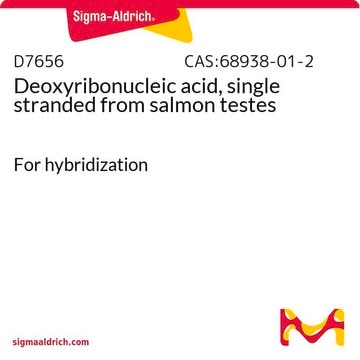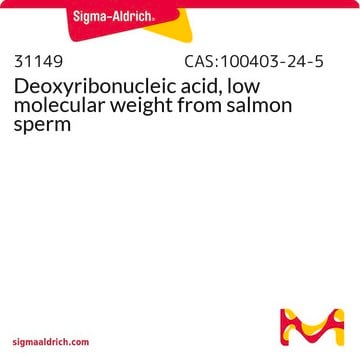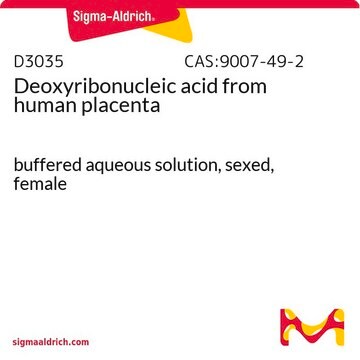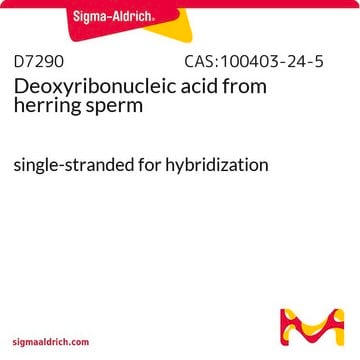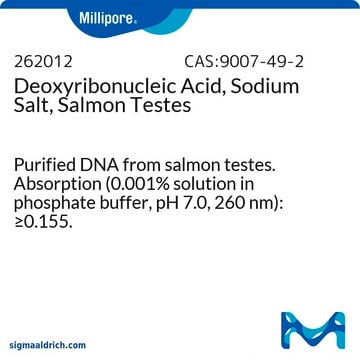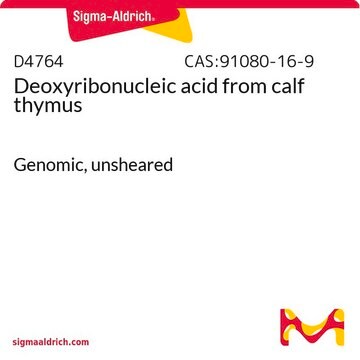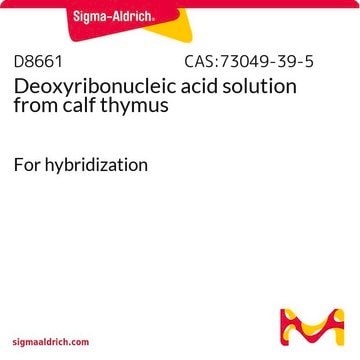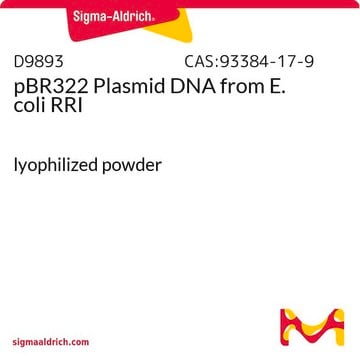D4889
Deoxyribonucleic acid sodium salt from Escherichia coli strain B
Genomic, unsheared
Sinônimo(s):
DNA
Faça loginpara ver os preços organizacionais e de contrato
About This Item
Número CAS:
Número CE:
Número MDL:
Código UNSPSC:
41106310
eCl@ss:
32160414
NACRES:
NA.52
Produtos recomendados
grau
for molecular biology
Nível de qualidade
forma
lyophilized powder
peso molecular
>45 kb
temperatura de armazenamento
2-8°C
Procurando produtos similares? Visita Guia de comparação de produtos
Categorias relacionadas
Descrição geral
Escherichia coli strain B is most widely studied DNA after k-12. The genomes of E coli strain B and k-12 show differences in the IS sequence elements. Strain B have B-islands and express O-specific side-chain LPS. The product is unsheared genomic DNA.
Especificidade
50% GC; Tm = 90.5 °C
Aplicação
The DNAs are particularly useful for genomic analysis, including PCR, library construction in bacteriophage λ, and in heterologous pre-hybridization and hybridization protocols.
Deoxyribonucleic acid sodium salt from Escherichia coli strain B has been used for:
Deoxyribonucleic acid sodium salt from Escherichia coli strain B has been used for:
- PCR reactions of genomic DNA of Gardnerella vaginalis
- nick translation and radiolabeling of dNTP
- generating standard curve for 16S rDNA quantification
- transfecting neutrophils
- testing the extraction methods
Definição da unidade
One unit will yield an A260 of 1.0 in 1.0 ml of 1 mM Tris-HCl, pH 7.5, with 1 mM NaCl and 1 mM EDTA (1 cm light path).
Nota de preparo
Purified by anion exchange chromatography, dialyzed against a solution of 1 mM sodium chloride, 1 mM EDTA and 1 mM Trizma HCl, pH 7.5 and lyophilized at a concentration of approx. 2 units per mL. Approx. 20 A260 units per mg DNA. % GC is the percentage of G/C base pairs. Tm is the temperature at the midpoint of the thermal denaturation profile.
Nota de análise
Analyzed by gel electrophoresis and visualization after ethidium bromide staining, with single predominant band of 45 kB or greater.
Outras notas
DNA in solution will reanneal on standing at room temperature so it is recommended to boil the solution for 10 minutes and then cool on ice for at least 5 minutes prior to use.
produto relacionado
Nº do produto
Descrição
Preços
Código de classe de armazenamento
11 - Combustible Solids
Classe de risco de água (WGK)
WGK 3
Ponto de fulgor (°F)
Not applicable
Ponto de fulgor (°C)
Not applicable
Equipamento de proteção individual
Eyeshields, Gloves, type N95 (US)
Certificados de análise (COA)
Busque Certificados de análise (COA) digitando o Número do Lote do produto. Os números de lote e remessa podem ser encontrados no rótulo de um produto após a palavra “Lot” ou “Batch”.
Já possui este produto?
Encontre a documentação dos produtos que você adquiriu recentemente na biblioteca de documentos.
Os clientes também visualizaram
Johan Sukweenadhi et al.
Antonie van Leeuwenhoek, 106(5), 935-945 (2014-08-30)
Strain DCY84(T), a Gram-stain positive, rod-shaped, aerobic, spore-forming bacterium, motile by means of peritrichous flagella, was isolated from humus soil from Yongin forest in Gyeonggi province, South Korea. Strain DCY84(T) shared the highest sequence similarity with Paenibacillus barengoltzii KACC 15270(T)
Rudolph Spangler et al.
PloS one, 4(9), e7010-e7010 (2009-09-16)
PCR in principle can detect a single target molecule in a reaction mixture. Contaminating bacterial DNA in reagents creates a practical limit on the use of PCR to detect dilute bacterial DNA in environmental or public health samples. The most
Genomic comparisons among Escherichia coli strains B, K-12, and O157: H7 using IS elements as molecular markers
Schneider D, et al.
BMC Microbiology, 2(1), 18-18 (2002)
Mohamed El-Agamy Farh et al.
Journal of microbiology (Seoul, Korea), 55(10), 767-774 (2017-09-29)
Gram-staining-negative, uniflagellated, rod-shaped, designated as DCY110
Yue Huo et al.
Current microbiology, 76(1), 22-28 (2018-11-02)
A Gram-positive bacterium (DCY118T) was isolated from ginseng-cultivated soil in Gochang-gun, Republic of Korea. This isolate was assigned to the genus Ornithinimicrobium and is closely related to Ornithinimicrobium kibberense K22-20T (98.8%), O. pekingense DSM 21552T (98.5%), O. algicola JC311T (98.2%)
Nossa equipe de cientistas tem experiência em todas as áreas de pesquisa, incluindo Life Sciences, ciência de materiais, síntese química, cromatografia, química analítica e muitas outras.
Entre em contato com a assistência técnica
